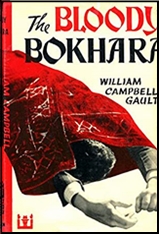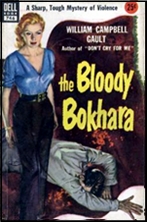Wed 1 Mar 2023
Reviewed by Tony Baer: WILLIAM CAMPBELL GAULT – The Bloody Bokhara.
Posted by Steve under Reviews[4] Comments

WILLIAM CAMPBELL GAULT – The Bloody Bokhara. Dutton, hardcover, 1952. Dell #746, paperback, 1953.
Lee Kapralian is twenty-six, second generation Armenian, WWII vet for the red white and blue, all-American in his heart, and handsome as the devil’s twin. His father is of the older generation, and doesn’t want his kids losing their culture mixing romantically with Americans.
Lee works for his father in a Persian rug store. Persian rugs aren’t as popular as they used to be and it’s a hard way to make a living. Most folks don’t see the difference between hand woven ancient rugs and wall to wall carpeting. They both cover the floor. And carpets are cheaper and brand new.
Life is okay enough for Lee, if steeped in tepid mediocrity, until Claire walks into the store. She’s gorgeous as Satan’s mistress and twice as dangerous.
Claire’s got some rugs she’d like appraised. Would Lee come back to her apartment with her to check them out?

Would I? Yeah. Uh-huh. Oh, sure. I’ll take a look at your rugs, lady. And he does. And they are beautiful, rare and fine. Like Claire. But one of the rugs has a bloodstain. A bloody bokhara (which is a type of rug : the bokhara part — not the blood; the blood washes right out like a bloated body upon the shore).
And the bloodstain bespeaks its provenance. Like Claire.
And does Lee like Claire! Whoa. He’s gone for her. A Gone Guy. And surprisingly, she for him. I mean — at least that’s what she tells him. And who is he to question beauty. Who gives and gives. And takes.
Lee, the ordinary, extraordinarily handsome guy, leaves his family for the girl and his father’s business for selling these bloody rugs. Giving them a good washing first. Of course. Claire asks if it’s okay if she takes a shower. Of course, Claire. Of course.
In the end the shocker is there’s really no shocker. It kind of goes the way it should go. But it could’ve plausibly gone in many other ways. And the anticipation is the thing anyway. There’s nothing but anticipation. Fear and hope are never here. They never come. Yet we dwell on them. Til our very last breath.
It’s a well done book, and notable for being a story of mid-century Armenian family dynamics woven into a fairly typical noir — using Persian rugs as the mcguffin to tie in the dissolution of the Armenian family, the forgetting of history, to the squandering of one’s moral fiber in pursuit of a buck and a beauty. A carpet for a rug. With just the faintest hint of red.
March 1st, 2023 at 7:29 pm
This is one of only a few of Gault’s mysteries that as it so happens I’ve never read. It’s also one of only 3 or 4 of his 30-something books that doesn’t feature one of his two PI’s, Joe Puma or Brock the Rock Callahan. (That might have something to do with it.)
So thanks for the review, Tony. It’s good to know more about this one at last.
March 1st, 2023 at 9:29 pm
Gault a bit more novelistic and ambitious than usual, and not entirely successful at it, but the instincts are there and the writing, as always, superior.
Beautifully written review Tony, it captures a bit of the feel of the work and gives the reader a good idea of what to expect without giving anything away.
March 6th, 2023 at 2:06 am
Nice review.
Coincidentally, I was reading the November 1948 issue of Black Mask, where the novella that was the source for this was published. I haven’t read the paperback though.
In the magazine version, there are obvious parallels to the Maltese Falcon. Lee, the protagonist, inhabits a world halfway between his parents’ and his peers, like most kids of immigrants. Claire is the temptress who lures Kim towards the dark side of the American dream, a place where money comes easy if you can hold your nose, close your eyes and years to the moral decay around you. The carpet is the McGuffin.
Gault doesn’t offer the usual simplistic pulp resolution; showing us the darkness in man’s hearts. But there is a tiny glimmer of hope for Lee and Claire at the end.
A good story. Gault deserves to be rediscovered.
March 6th, 2023 at 5:59 am
Sal,
Yes, there is that glimmer of hope at the end. And that too echoes the Maltese Falcon where spade tells Brigid O’Shaughnessy that he’ll wait for her. Though here it is more sincere since Claire’s prison term is far shorter.